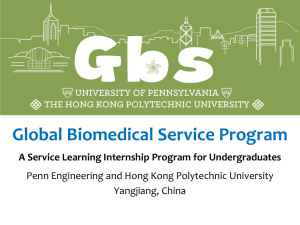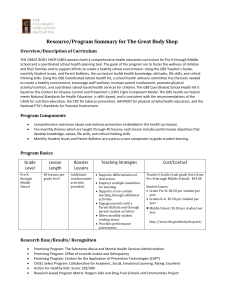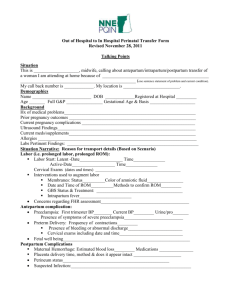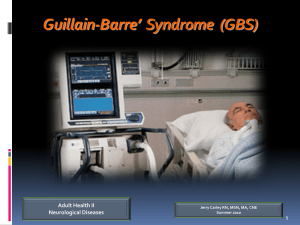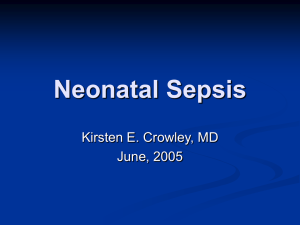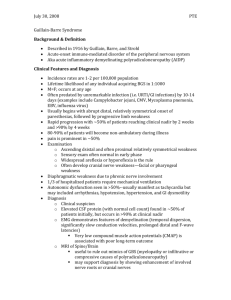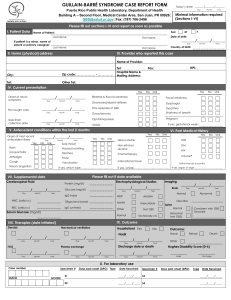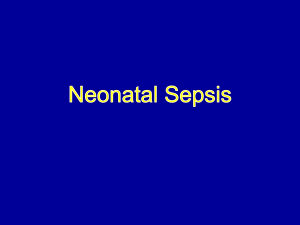Maternal risk factors for early onset sepsis (EOS)
advertisement
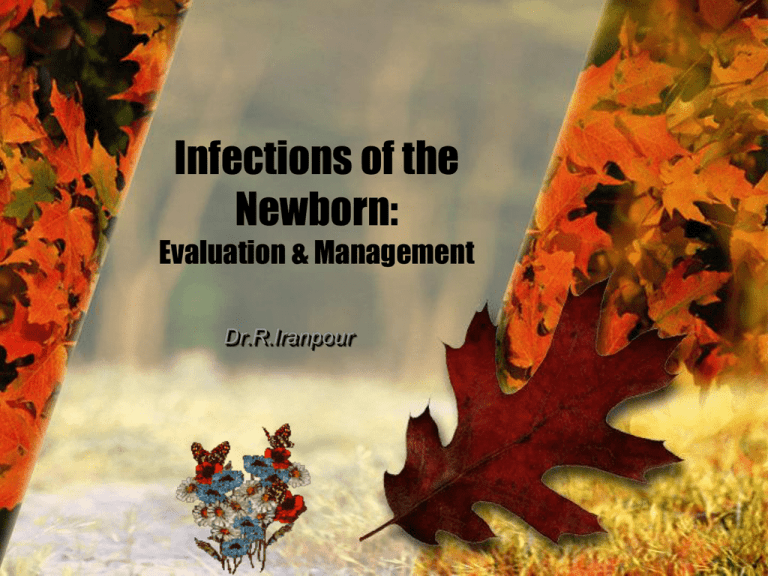
Infections of the Newborn: Evaluation & Management Dr.R.Iranpour Today`s Menu Background statistics Why babies are more vulnerable Risk factors Clinical signs Screening Workups Treatment Aftermath Future Trends Background Statistics Neonatal literature says: Actual infection rate 1-8/1000 newborns LBW infection rate 1-2/100 newborns Historical Changes in Predominant Infectious Agent 1930´s: Group A Strep 1940´s: E.coli 1950´s: Staph aureus 1970´s: Group B Strep Setting Priorities Newborn are not small children Remember that 10 babies are worked up for each proven case Neonatal Vulnerability Immature immune system (slow to react,decreased IgG and complement production, poor phagocytosis, poor migration) Unavoidable exposure to pathogenic organisms in birth canal Peripartum stress Invasive procedures Exposure to highly resistant nosocomial organisms in NICU CHARACTERISTICS OF NEONATAL SEPSIS EARLY ONSET LATE ONSET LATE, LATE ONSET Timing Less than 4-7 days of life 7 days to 3 months More than 3 months Transmission Vertical; organism often acquired from mother’s genital tract Vertical or via postnatal environment Usually postnatal environment organisms GBS, E.coli, listeria, non-typeable haemophilus influenza and enterococcus Staph coag-negative, staph.aureus, pseudomonas, GBS, E.coli and listeria Candida, staph coagnegative, Clinical manifestation Fulminant course, multisystem involvement, pneumonia common Insidious, focal infection, meningitis common Insidious mortality 5%-20% 5% Low Risk Factors Maternal risk factors for early onset sepsis (EOS) Neonatal risk factors for infection Maternal risk factors for early onset sepsis (EOS) chorioamnionitis PPROM GBS colonization of current pregnancyThe infant of a colonized mother is at 25 times the risk for EOS A previous affected infant with GBS GBS bacteriuria and untreated maternal urinary tract infection prolonged ROM is taken as 18 hours Intrapartum or immediate postpartum maternal fever > 38 C malnutrition sexually transmitted disease lower socioeconomic status maternal substance abuse Mother to Infant Transmission GBS colonized mother 50% 50% Non-colonized newborn Colonized newborn 98% Asymptomatic 2% Early-onset sepsis, pneumonia, meningitis Neonatal risk factors for infection Prematurity Low birth weight Indwelling catheter Endotracheal tube Low Apgar score (<6 at 1 or 5 min); birth asphyxia Meconium staining Congenital anomalies Multiple gestation Prevention strategy for early-onset (GBS) disease Vaginal/Rectal cultures at 35 to 37 weeks in ALL pregnant women Intrapartum prophylaxis indicated •Previous infant with invasive GBS OR •GBS bacteriuria in current pregnancy OR • Positive GBS screening culture OR •Unknown GBS status AND •Delivery at < 37 OR •ROM ≥ 18 hours OR •Intrapartum Tem ≥ 38 C ACOG Committee Opinion #279, Dec 2002 Intrapartum prophylaxis not indicated •Previous pregnancy with positive culture •Planned section with intact Membranes (regardless of maternal GBS culture status) •Negative GBS screening culture (regardless of intrapartum risk factor) Updated algorithm for women with threatened preterm delivery Onset of labor OR ROM at < 37 wk, with significant risk for imminent preterm delivery GBS positive GBS negative Obtain vaginal & rectal GBS culture and initiate penicillin Penicillin (IV) ≥ 48 hr (during tocolysis) No GBS prophylaxis No growth At 48 hr IAP at delivery No GBS culture Stop penicillin Management of Patients with PPROM Clinical Signs(1) Not breathing well Not feeding well Not looking well Clinical Signs(2) Respiratory “dusky spell” Tachypnea-sensetive but nonspecific-respiratory distress in term newborn is sepsis until proven otherwise Apnea in normal newborn-septic W/U and supportive measures Clinical Signs(3) Feeding “not hungry” Distension Residuals Vomiting Hem-positive stools watery or mucousy stools Clinical Signs(4) Appearance Lethargic Mottled Poor perfusion Temperature instability (not necessarily fever, but fever is more specific) Early-onset jaundice Clinical Signs(5) Ominous Late Signs Apnea Seizures Hypotension/Shock Clinical signs(6) Sepsis-like Presentations: Ductal-dependent congenital heart disease CAH Inborn errors of metabolism(IEM) Approach to all neonates born with suspicious EOS SIGNS OF INFECTION NO SIGNS OF INFECTION Suspected Chorioamnionitis or previous EOGBS infants No or Inadequate Intrapartum Antibiotics Gestation <35 wk NO Risk Factors Maternal Risk Factors Gestation ≥ 35 wk Adequate Intrapartum Antibiotics Gestation <35 wk CBC, IT ratio, CRP Observe for 48 hrs Normal Care Gestation ≥ 35 wk Observe 24-48 hrs Symptomatic infants, or Abnormal CBC, IT ratio, CRP ADMIT TO NEONATAL UNIT Sepsis workup- CBC, IT ratio, CRP and blood Culture Commence ampicillin and an aminoglycoside IV ( include cefotaxime IV for meningitis) Other investigation according to clinical indication ( e.g. LP, CXR, gastric aspirate, skin swabs) Screening CBC with manual diff WBC:up ,down ,or normal ANC , I/C ratio Left shift helpful but may be delayed Unexplained thrombocytopenia PT/PTT suddenly abnormal Blood sugar may be high or low-change in pattern ESR and CRP? Varies from center to center CIE or Latex fixation for GBS?Numerous false positives. Gastric aspirate or ET aspirate?Not very specific Workup(1) Workup during early sepsis Blood culture Amniotic fluid or placenta culture if available ET aspirate(if intubated) Very low yield for LP or urine cultures in first 24 hours unless specific clinical indication LP later if B/C positive or specific symptoms-but note that 10-15% of babies with positive LP´s have negative blood cultures Workup(2) Classic septic workup (late) Blood culture LP Urine-catherized or suprapubic aspirate ET aspirate if intubated Surface cultures skin/eye/secretion Stool culture if stools abnormal CXR Abd.X-ray if symptomatic Workup(3) Goals of workup Recover organism Determine septic antibiotic Determine antibiotic doses Determine length of therapy Treatment(1) Antibiotics General supportive measures IVIG? GCSF or GMCSF? Treatment(2) General supportive measures Assisted ventilation and/or oxygen as needed IV and possibly arterial access NPO,NG suction if needed Volume support ,pressors Transfuse if indicated FFP/cryo if clotting disorders Thermal regulation/support Treatment(3) Selection of antibiotics based on: Age of onset Location(home vs. hospital) Maternal history Known colonization Epidemic situation etc Treatment(5) Antibiotic selection Early- onset sepsis: usually Ampicillin & aminoglycoside Late onset for premie in hospital (nosocomial): Vancomycin & Aminoglycoside (or drug specific to known colonization or epidemic situation such as Ceftazidim ,Imipenem ,cefotaxim,…) Abdominal Catastrophes: Ampicillin & aminoglycoside & metronidazol Late onset home: Ampicillin & Cefotaxim Non-hospitalized meningitis: ampicillin & aminoglycoside & cefotaxim Late-onset hospitalized meningitis: vancomycin & ampicillin & aminoglycoside (or cefotaxim) Fungus: Amphotricin B ,5FC ,etc. Aftermath(1) How long to treat? Was organjsm recovered? Where was organism found? Clinical course? Repeat cultures? Sequelae? Few in uncomplicated neonatal sepsis Frequent with NEC,gram-ve meningitis Aftermath (2) Negative cultures and course not consistent with infection: 48-72 hours of treatment UTI - 7-10 days treatment, screen for renal anomalies Sepsis/NEC - 10-14 days of treatment Meningitis: 14 days (GBS), 21 days (gram-negative), Osteo - prolonged treatment, Future Trends GCSF or GMCSF Monoclonal antibodies Prophylaxis - various modes

